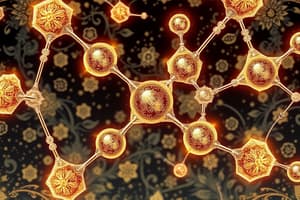Podcast
Questions and Answers
Which of the following statements about the molecule is true?
Which of the following statements about the molecule is true?
Which of the following statements about boiling points is true?
Which of the following statements about boiling points is true?
Which of the following statements is true?
Which of the following statements is true?
Which of the following pure substances has hydrogen bonding?
Which of the following pure substances has hydrogen bonding?
Signup and view all the answers
Which of the following statements about esters is true?
Which of the following statements about esters is true?
Signup and view all the answers
Which of the following is not an oxidising agent?
Which of the following is not an oxidising agent?
Signup and view all the answers
Which of the following products is formed when hydrogen/Pt catalyst is reacted with 3-ethylpentanoic acid?
Which of the following products is formed when hydrogen/Pt catalyst is reacted with 3-ethylpentanoic acid?
Signup and view all the answers
Which of the following statements about intermolecular forces is true?
Which of the following statements about intermolecular forces is true?
Signup and view all the answers
What is the structure of the compound 3-ethyl-4-fluoro-2-hydroxyheptanal?
What is the structure of the compound 3-ethyl-4-fluoro-2-hydroxyheptanal?
Signup and view all the answers
What is propyl benzoate?
What is propyl benzoate?
Signup and view all the answers
What is 2-chloro-3-methylhexenoic acid?
What is 2-chloro-3-methylhexenoic acid?
Signup and view all the answers
Study Notes
Bonding and Structure
- The bond between carbon 1 and carbon 2 in the given molecule consists of one sigma bond and one pi bond.
- There are 11 sigma bonds in the molecule.
- The bond between carbon 5 and carbon 6 is sp3-sp3 orbital overlap.
- The bond between carbon 1 and carbon 2 is sp3-sp2 orbital overlap.
Boiling Point
- Chloroethane has a higher boiling point than chloromethane due to increased van der Waals forces.
- Propanoic acid has a higher boiling point than ethanoic acid due to increased van der Waals forces.
- Heptane has a higher boiling point than ethoxy pentane, as longer chain alkanes have stronger van der Waals forces.
- Butanamine has a higher boiling point than diethyl ether due to the possibility of hydrogen bonding.
Intermolecular Forces
- Carbon hydrogen bonds are non-polar because of the similar electronegativity values for the carbon and hydrogen atoms.
- In the carbonyl functional group, there is uneven sharing of electrons in the bond, so that the carbon is slightly positive and the oxygen slightly negative.
- Hydrocarbons are non-polar and can only participate in dispersion forces.
- Carboxylic acids are very polar and can form hydrogen bonds with water, making them soluble in water.
Hydrogen Bonding
- 2-aminopropanal and pentanoic acid have hydrogen bonding due to the presence of an -NH2 and -COOH group, respectively.
- 3-oxo-2-butanone and propyl acetate do not have hydrogen bonding because they lack a hydrogen atom directly bonded to a highly electronegative atom.
Esters
- Esters have pleasant, fruity odours.
- Ethanol and pentanoic acid react to form ethyl pentanoate.
- Hydrolysis of butyl hexanoate will form hexanol and butanoic acid.
- The esterification reaction is reversible.
Oxidizing Agents
- Hydrogen gas with a metal catalyst is a reducing agent, not an oxidizing agent.
- Tollens' reagent, Acidified potassium dichromate, and Ozone gas are oxidizing agents.
Reduction
- 3-ethylpentanoic acid when reacted with hydrogen/Pt catalyst will form 3-ethylpentanal, an aldehyde.
- Aldehydes are not primary, secondary, or tertiary alcohols.
Reactions
- Ketones cannot undergo hydrogen bonding with each other due to the absence of a hydrogen atom directly bonded to the oxygen in the carbonyl group.
- Alkenes can undergo weak dipole-dipole interactions, while alkanes can only participate in dispersion forces.
- In water, aldehydes can hydrogen bond with water molecules due to the presence of a polar carbonyl group.
- Carboxylic acids have strong hydrogen bonding because of the presence of a -COOH group, capable of forming two hydrogen bonds.
Nomenclature
- 3-ethyl-4-fluoro-2-hydroxyheptanal has 7 carbon atoms in the longest chain (heptanal).
- The IUPAC name of propyl benzoate is propyl benzoate.
- 2-chloro-3-methylhexenoic acid has 6 carbons in the longest chain (hexanoic acid), and an alkene group.
Drawing Structures
- Be able to draw organic structures from their IUPAC names or given descriptions.
- Ensure you understand the placement of functional groups, substituents, and double/triple bonds.
- Pay attention to the stereochemistry of the molecule if it is provided.
Reaction Mechanisms
- Be familiar with common reactions such as:
- Esterification
- Hydrolysis of esters
- Addition reactions
- Oxidation and reduction
- Sn1 and Sn2 reactions
- Be able to write reaction equations and explain the steps involved in each mechanism.
Organic Chemistry
- Understand the basic concepts of organic chemistry, such as:
- Structure and bonding
- Functional groups
- Isomers
- Nomenclature
- Reactions
- Spectroscopy (NMR, IR, Mass Spectrometry)
Biochemistry
- Understand the basic concepts of biochemistry, such as:
- Carbohydrates
- Lipids
- Proteins
- Nucleic acids
- Enzymes
- Metabolism
- Cellular respiration
Study Tips
- Review solved examples.
- Practice drawing structures and writing reactions.
- Make flashcards to memorize important concepts.
- Utilize online resources and textbooks.
Studying That Suits You
Use AI to generate personalized quizzes and flashcards to suit your learning preferences.
Related Documents
Description
This quiz covers key concepts related to bonding and structure in organic molecules, including sigma and pi bonds. It also explores boiling points and the role of intermolecular forces in various compounds. Test your understanding of these fundamental organic chemistry principles.




